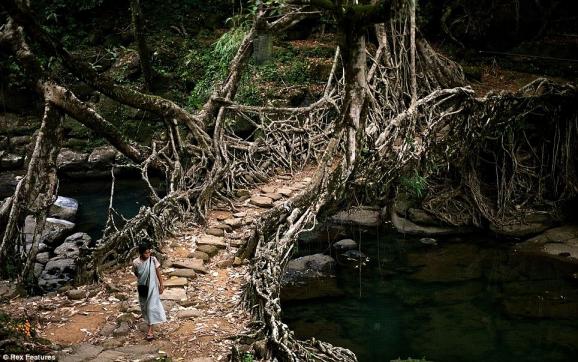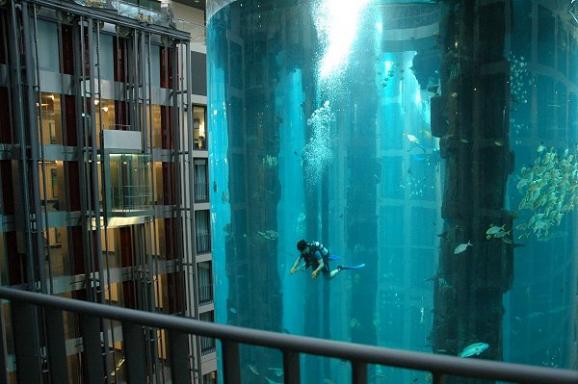The bathroom of the stunning new penthouse in Guadalajara, México, is situated on top of an unused 15-story elevator shaft...
Pfff... in South Africa we call that a fancy longdrop...
Sunday 10 November 2013
Saturday 28 September 2013
Save water brick
It might look like your typical old red clay house-building brick on one side, but turn it over and there is a shift that hints at a deeper design change – one that is eco-friendly but also expressive in a way that most walls or brick are not.
Designed by Jin-young Yoon to be made from recycled plastic and decomposed leaves, this brick is green from the ground up (so to speak). More than just its composite materials, however, built-in grooves are designed to funnel water for gardening or even long-term underground storage.
In a world where water is becoming the next hot-button resource destined to become scarce, it seems like a good time to start thinking about our most basic building materials and structures (such as bricks and walls) and see how they might shift to accommodate an ever-growing need for homes to have access to nature’s most vital resource.
Related articles:
Group Has Plans for Sustainable Fashion District in NYC
How can I make my morning coffee more environmentally friendly? 5 tips.
Eco-friendly features shine at the WTC
Friday 27 September 2013
Monday 9 September 2013
Turning waste into architecture
Parasitic Prototype 7
By: Sean Hanmer – Canterbury School of Architecture
Kent, United Kingdom
Parasitic Prototype 7 is about the reusing and the cannibalisation of an existing structure, in this situation – the Greenwich Power Station. Using a power station, itself a symbol of profligate use of energy seemed very apt for a project, which stimulates a process of recycling (plastic) waste into architecture. Capitalist demands for urban growth exist but this scheme re-uses of a brownfield site, reduces urban sprawl into the suburban greenbelts. It moves away from this 1 bottle = 1 bottle philosophy and mediating a change in society, towards a more sustainable environment and a more dynamic society. Promoting the recycling of material waste into a new system, which has the capacity to reprocess waste into a product that can perform a superior – longer life-span function, keeps plastic waste away from our landfills and oceans.
The proposed prototype has the ability to print itself using 3D printing technology, taking in all the plastic wastes that were previously deemed too economically unviable for recycling and reprocessing them for fused deposition modelling, printing the external skin and internal components of the skyscraper. The rate at which the prototype reaches its predefined resolution is dependant on the amount of recycled material being pumped into the mechanism and the economic demand for growth. As a result of this, the intervention has no period of completion date, resulting in an ‘architecture in flux’. Continuous changes in programme will influence the development of construction. Therefore the skyscraper has been designed with adaptability in mind, allowing for the continuous reprinting of its internal floor plans and also allowing for different programmes to occupy the prototype. This is key to the survival of the intervention, supporting economic development through progression, inflation and recession.
Source: http://www.gurroo.com/designart/innovative-minds-architectural-design-competition/
Thursday 5 September 2013
Renovation of a 300+ year old house
Located in the ancient port city of Jaffa, the oldest part of the Tel Aviv-Jaffa municipality in Israel sits this 300-plus year-old house that has been renovated by Pitsou Kedem Architects, already well known for their minimalist approach to architecture and design.
The owner of the house asked the designers to maximize the sea view while keeping the historical feel of the building intact. The project team from Pitsou Kedem, Irene Goldberg and Raz Melamed, achieved this beautifully.
The residence consists of a 100 square meter (1,076 sq.ft) living area (living, dining and kitchen) plus an additional 80 square meters (861 sq.ft) that includes the master bed room, a study and a guest room.
Sources: http://www.thecoolhunter.net
http://www.thecoolist.com
Friday 30 August 2013
Saturday 10 August 2013
Wednesday 7 August 2013
London based firm, Haworth Tompkins renovated a dilapidated old building situated on the internationally renowned music campus, Dovecote Studio at Snape Maltings. Nestled within the shell of an abandoned building, the firm responded to the existing conditions with a touch of sensitivity, perfectly uniting the old structure with the new aesthetic.
The exisiting ruins once formed a two-storey brick dovecote, and although decayed, the enigmatic quality of this ruin became well known to concert-goers and visiting musicians. “Its crumbling brickwork and rusting window grilles embodied the site’sromantic dereliction, and the balance between decaying buildings and marsh landscape which first drew Benjamin Britten to Snape.”
The new studio builds upon the original industrial feel on the campus and almost seems to gracefully grow from the old. The new part of the structure is cladded in Corten weathering steel and is understood as a separate entity, yet compliments the existing shell with its rust-red shade almost matching the red bricks.
“The result is a building that from a distance evokes the ghost of the original structure, but, seen from close to, reveals itself as entirely new.”
The ruin had to be stabilized prior to inserting the new structure. Suffolk Welding crafted the steel into a single weather tight form. The sides and roof planes are made of full size 1200 x 2400mm sheets with regular staggered welded joints, into which door and window openings were cut in locations dictated by internal layout. Each panel was prefabricated by local steelworkers, then delivered to site to be assembled in a compound next to the brick ruin.
Wednesday 31 July 2013
GREEN bridge
So how does one create a "green" bridge? Like this, the old school way...
In northeastern India, they make bridges by weaving living branches and roots of trees. These bridges are increasingly strong and can remain operational up to 500 years.
In northeastern India, they make bridges by weaving living branches and roots of trees. These bridges are increasingly strong and can remain operational up to 500 years.
Thursday 6 June 2013
Dairy Lumion renderings
So here are some of the renderings I did in Lumion. We had to design a dairy for the Crossways farm village as our second studio work project for the BTech year.
Thursday 30 May 2013
Huge aquarium
Remember wanting an aquarium growing up? Well, i don't know about you, but mine didn't really look like this one...
Located at the Radisson Blu Hotel in Berlin, the AquaDom is a 25 metre tall cylindrical acrylic glass aquarium with built-in transparent elevator.
Subscribe to:
Posts (Atom)


















































